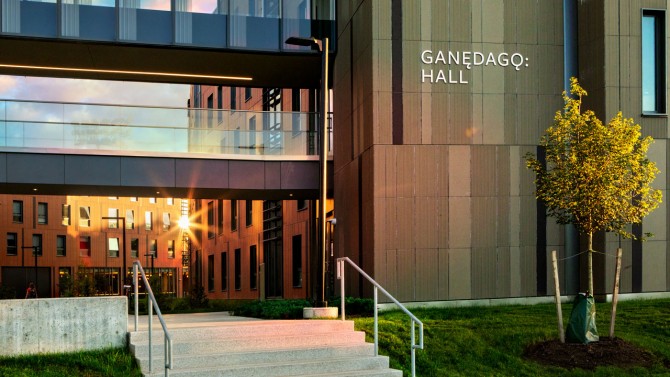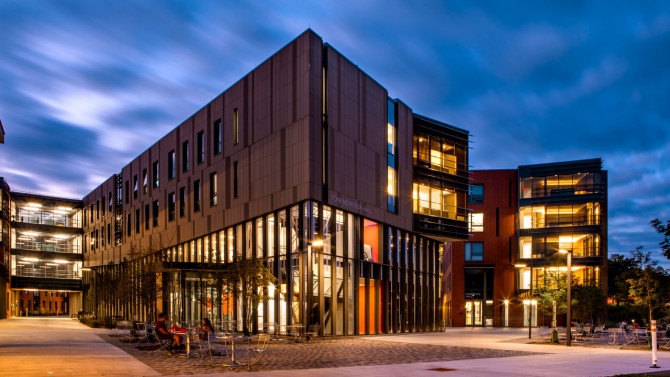Students living in the newly opened residence buildings – Toni Morrison Hall and Ganędagǫ: Hall – know of the buildings’ rooftop solar panels. But if the windows and walls could talk, they would be fluent in the language of sustainability.
“These new buildings are incredibly energy- and resource-efficient, and they provide the student-residents a great deal of comfort,” said Chris Davenport, project manager of the North Campus Residential Expansion (NCRE) complex. “These buildings have a weather-tight and airtight envelope, they create electricity, they are cooled by [Cayuga Lake] and one day they could be warmed by renewable energy.”
The buildings were designed and built in line with Cornell’s high standards for green infrastructure, a critical component to advancing the campus goal of carbon neutrality by 2035.
Thanks to highly efficient walls, windows and rooftop solar arrays, Ganędagǫ: Hall is among the most energy-efficient buildings on campus.
By the end of October, the installed solar panels on top of Morrison and Ganędagǫ: halls will be commissioned and put into service, with 736 high-efficiency solar panels generating 408 kilowatts of energy. When all five residence halls in the NCRE are complete – Ruth Bader Ginsburg Hall, Barbara McClintock Hall and Hu Shih Hall will be completed by late summer 2022 – the rooftop solar panels will generate 1.1 megawatts of electricity, providing 35% of the electric energy for the NCRE group, according to Matt Kozlowski, Cornell’s Green Building Program manager.
Combining solar energy and the university’s Lake Source Cooling, the buildings will see a 42% to 46% reduction in energy costs, when compared to standards used by the American Society of Heating, Refrigerating and Air-Conditioning Engineers.
“By adding solar panels to these rooftops, it’s an expression of Cornell’s commitment to sustainability,” Kozlowski said. “It’s tangible and creates a significant amount of renewable energy that’s beneficial both for campus and the surrounding community.”
The five new residence halls’ solar arrays pack an eco-friendly, solar-power punch. In comparison, the rooftop panels will generate about half of the energy received from Cornell’s Snyder Road Solar Farm, an 11-acre, 2-megawatt facility commissioned in 2014, located adjacent to the Ithaca Tompkins International Airport.
“For the residence halls, the footprint is much smaller than the Snyder Road solar farm,” Kozlowski said. “The panels for this project are smaller, very efficient and have a high-power output.”
Nearly everything else about the buildings is green, too. The terra cotta exterior walls have a high R-value (insulation performance) rating of 25.5. The walls are 12 inches thick, with efficient insulation sandwiched between eight inches of concrete, according to Davenport. The window glazing has a very efficient U-factor (non-solar heat flow) of .27, and the high-reflectance roofing (R-value of 49) mitigates heat-island effects.
State-of-the-art LED lighting with occupancy and daylight sensors reduce energy use by 25%, which exceeds building code standards. Indoor water usage was reduced by 35% from the residence hall baseline by using low-flow and low-flush fixtures.
Even the surrounding landscape is eco-friendly, with drought-resistant plants and trees such as elms, magnolia and switchgrass, Davenport said.
The residence halls are built with the kind of hot water piping needed for Cornell’s transition to a renewable source of heating for the campus.
“These buildings will require little to no work within the building to make that adjustment,” Davenport said. “They are all ready and we can literally just plug it in.”









